On our 2,400 mile journey along Route 66, Da Viking and I were intrigued by unique roadside attractions and curiosities. At St. Louis University we searched for “The Billiken.” As we strolled on campus we passed by their baseball field.

We marveled at the baseball banner with this character’s face proudly displayed. As I reflected on my school mascots a “Pioneer” and a “Bronco” I thought about how they aren’t really ordinary either, yet, the “Billiken” still struck me as bizarre. How did the school decide on THIS slogan for their emblem?
We approached the semi circular plaza where we located the enthroned statue. The Billiken. I asked the statue, “Why?”
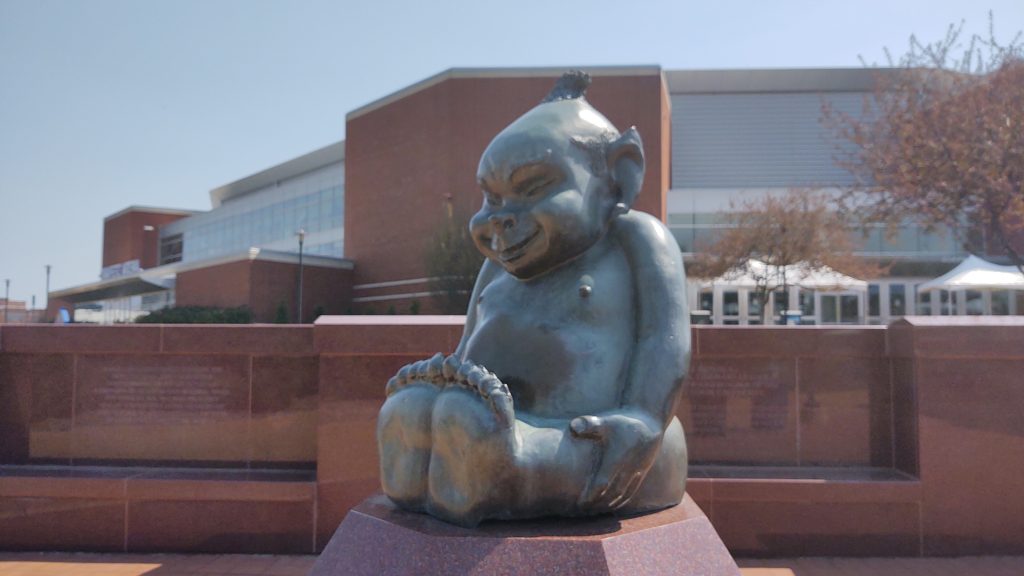
St. Louis University Mascot
He didn’t answer, so we read the plaque, “The God of Happiness, God of Luck and The God of Things As They Ought To Be.” The sentiment appeared wholesome, but doctrinal and ‘churchy.’

Billiken reminded me of Buddha, an Asian religious figure. Maybe we shouldn’t have mocked it. The St. Louis University students appear completely comfortable with this ‘happy’ creature as their athletic amulet.
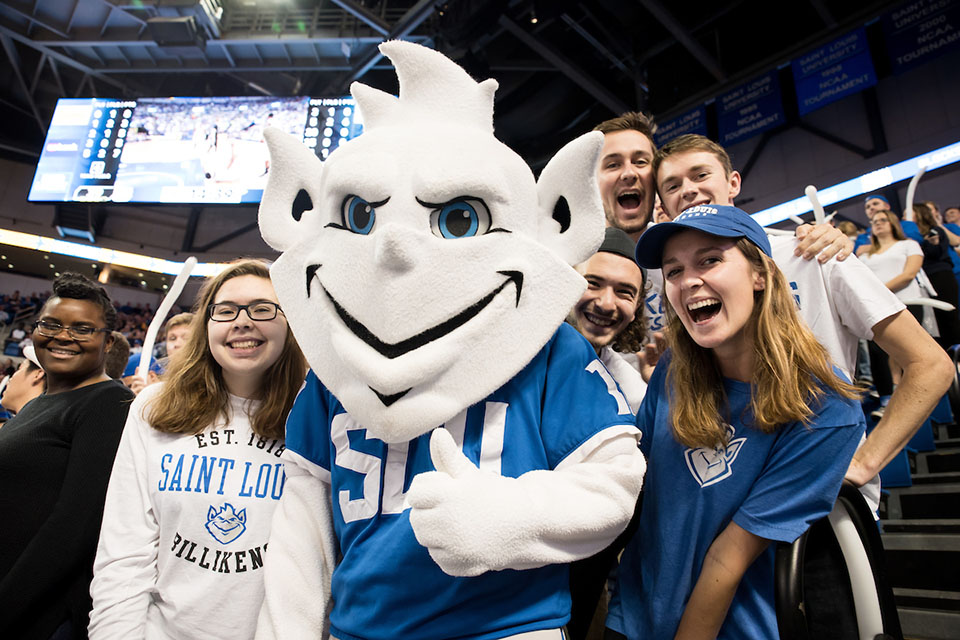
Photo Credit: St. Louis University Website
In 1908 Florence Pretz, an art teacher, created this sculpture. She took the name, “Billiken” from Bliss Carmen’s poem, “Mr. Moon: A Song Of The Little People.”
Many believed the Billiken character was a tribute to the new president of that time, William Taft. After all, his predecessor, Teddy Roosevelt had Teddy Bears created as an honor. (On Roosevelt’s out west hunting trip a young bear had been tied up so the president could have an easy shot. Teddy Roosevelt had refused to shoot the bear.) Teddy Bears are still popular today!
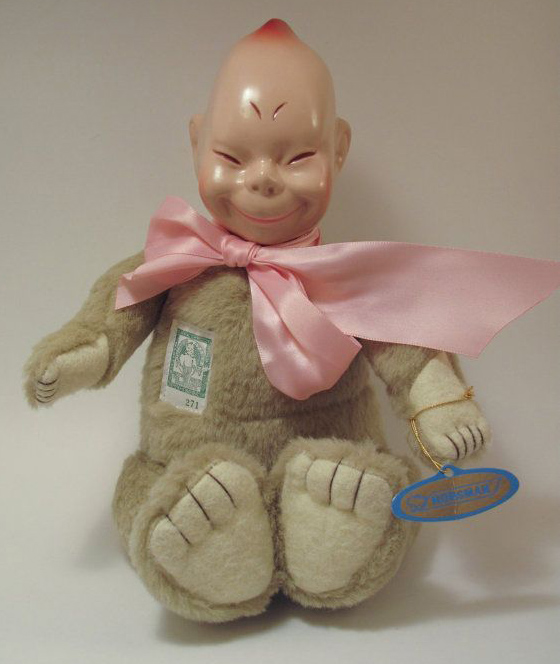
Photo Credit: Mondo Mascots Article
“The Bizarre History of the Billiken” by Chris
When interviewed in a 1912 Chicago Daily Tribune article Florence Pretz explained that she “got the inspiration for Billiken in 1896 while looking at a collection of grouchy looking gods belonging to Miss Floy Campbell of the art department at the school. They brought to Miss Pretz’s mind the idea of fashioning a god who would smile and bring to his worshippers cheer instead of gloom.” Florence Pretz believed she’d been Japanese in a past life.
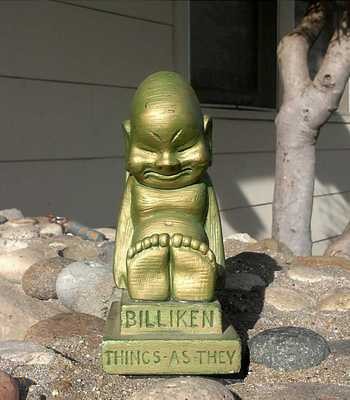
Photo Credit: Worth Point Website
In 1908 the first advertisements for the Billiken appeared in The Chicago Tribune. Each statue included a poem of happiness which set it apart from other toys of the time. The Billiken statue was sold at three locations in Chicago for $0.75 each. The figures were on display at The Craftsman Guild Shop on Wabash Ave, The Craftman’s Guild Kitchen on Michigan Ave and at Marshall Field & Co. On September 24, 1908 the Billiken Company was incorporated with three investors: Toby Rubovits, Charles P. Monash and James Rosenthal.
The gimmick of the Billiken caught on like a dog to a bone. Besides statues there were marshmallows, hatpins, dolls, cufflinks and pickle forks for example. Soon Billiken items were found on shelves throughout the United States. Buying a Billiken was thought to bring good fortune, but it was considered luckier to be given one, and luckiest of all if you steal it. (Restless Viking does NOT promote pilfering.)
Are you as surprised as me at the extensive sales for this good luck trinket? I suppose other gimmicks have taken hold, too, for example, “The Pet Rock” had been trendy in it’s day. But wait, there’s more. . .
When Herbert Vanderhoof’s editorial publication in The Canada West newspaper (1908), “Billiken and Canada West readers are old friends” sparked a retail market in our neighbors to the north. Billiken items were being snatched like frogs fetch flies.
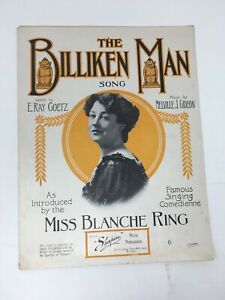
Photo Credit: Ebay
In fact, Blanche Ring recorded the song, “Billiken Man” in 1909 with Victor Records.
In 1909 investor and lawyer, James Rosenthal, set up an injunction to stop the production of “Killiblues.” These were dolls who came with uplifting poetry, just like the Billiken. I couldn’t find any “Killiblues” in my research, so I assume James Rosenthal was successful.
James Rosenthal and the other two investors approached Florence Pretz with an offer to pay her $30.00 each month for the rights to the Billiken merchandise. She agreed. Years later when interviewed by The Chicago Tribune she was asked, “Would you smash a Billiken if you had a chance?” Pretz replied, “I certainly would.”
The Billiken faded from the forefront as most fads do. That is until John Bender, a football coach at St. Louis University, embraced this good luck charm. It is said that John Bender resembled the large bellied, squinty eyed figure. His team became known as “Bender’s Billikens.” His one year of coaching (1910-1911) left a legacy. Today, the Billiken school spirit is still vibrant throughout campus!
Currently in Japan, Billiken statues and merchandise are prevalent. A 1996 comedy film, “Billiken” can be found on Japan’s Netflix.

This century old legacy of Billiken continues to live on as a good luck charm for many along with the St. Louis University students, staff and alumni. Unfortunately, Florence Pertz, the creator, became bitter about Billikens and was unable to fully financially benefit from this trend that she had started. Life passes by quickly. Making assumptions about statues (me) and missing opportunities (Florence Pertz) can cause regrets. Make the most of each day!
Resources
https://www.slu.edu/about/key-facts/what-is-a-billiken.php
http://churchofgoodluck.com/Billiken_History.html
https://www.worthpoint.com/worthopedia/vintage-billiken-statue-figurine-1908-406838137





